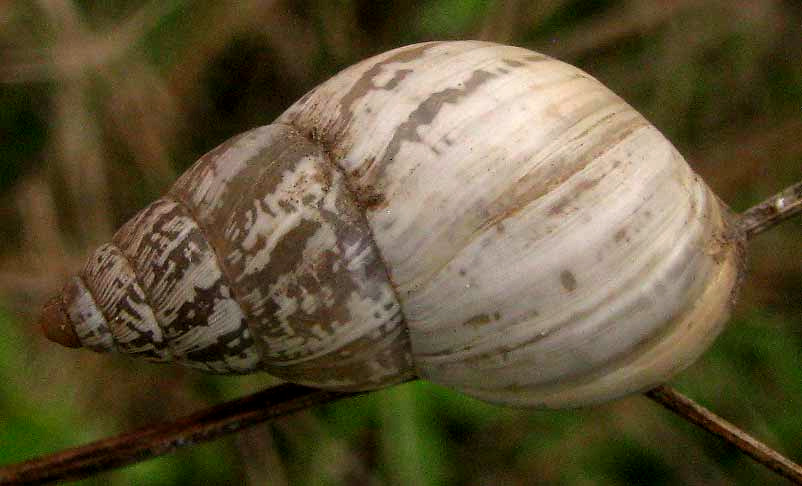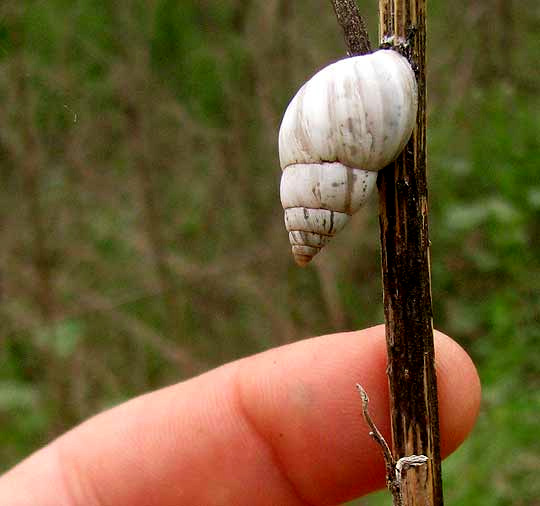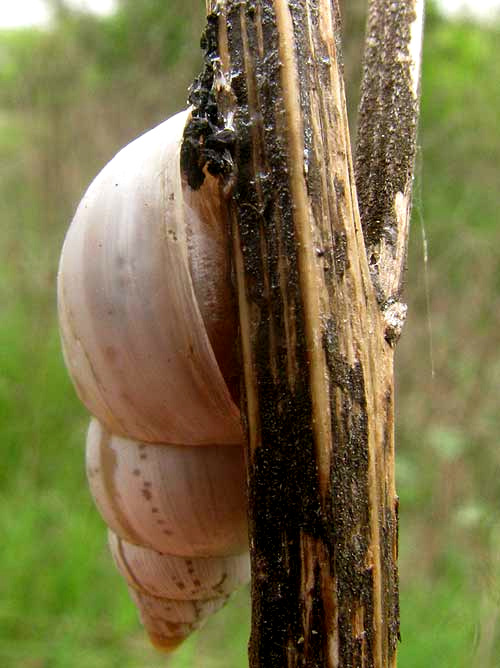Excerpts from Jim Conrad's
Naturalist Newsletter

from the April 27, 2014 Newsletter issued from the Frio Canyon Nature Education Center in the valley of the Dry Frio River in northern Uvalde County, southwestern Texas, on the southern border of the Edwards Plateau; elevation ~1750m (~5750 ft); N29.62°, W99.86°; USA
WHITEWASHED RABDOTUS SNAILS
At Cooks Slough Sanctuary and Nature Park on Uvalde's south side, in a low spot where water pools after rains, a couple of last fall's dead, weathered sunflower stems conspicuously bore white snail shells stuck to them about a yard (1m) above the ground. Below, you can see one, with my finger for scale showing that the shells were about ¾ inch long (2cm):

The shells were so white and eroded looking, that they seemed to belong to long dead snails, but of course the sunflower stems' age and the fact that the shells were glued to them suggested that this was the shells' normal appearance. Still, to convince myself that live snails still were housed inside the shells, I looked at the shells from behind and could see pale snail tissue, and what must have been black curds of dried snail poop, as shown below:

A closer look at a second snail's shell, showing subtly different patterning, appears at the top of this page.
Identification of the snails was helped by the same website that back in our days on the Yucatan's beaches was the place to go to learn the names of seashells. You can see that site's page for our snail, along with a distribution map showing where it's found in the US -- with us about in the center of it -- and the snail's white flesh, at http://www.jaxshells.org/deal.htm.
That page identifies our snails as the Whitewashed Rabdotus, RABDOTUS DEALBATUS, present not only in the US, mainly in the south-central states, but also in most of lowland Mexico.
One of the most interesting historical accounts I've read is "La Relación," by the Spanish conquistador Álvaro Nuñez Cabeza de Vaca, about his wanderings in what later became the US, including our area, first published in 1542. He chronicles the coastal Texas Mariame Indians collecting and eating snails during their wanderings collecting prickly pear fruits, or tunas, for food. Most likely, the main or only snail collected by the Mariame was our Whitewashed Rabdotus.
Evidence supporting that theory has been excavated at the J. B. White Archaeological Site on the Little River in central Texas, where thousands of Whitewashed Rabdotus shells turned up in long-buried strata of soil on which ancient indigenous Americans once camped. Because all the shells at that site were those of adult snails, which would have been collected for food while ignoring the smaller, younger ones, it's assumed that the shells were left there after their contents had been eaten.
You might enjoy the webpage describing daily life of the early Americans who lived at the J.B. White Site. The page is at http://www.texasbeyondhistory.net/jbwhite/dailylife.html.
That page suggests that the snails were probably cooked in pits in the ground using the stone-boiling method, a process illustrated on that page. You can also see many Whitewashed Rabdotus snail shells in the site's soil.
Ecologically, Whitewashed Rabdotuses are described as "calciphile," meaning that they prosper in soil with a high calcium content, such as that derived from limestone. In Texas the species often is encountered inside concrete culverts.